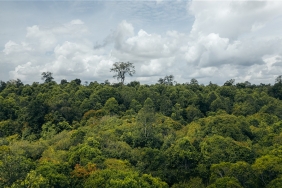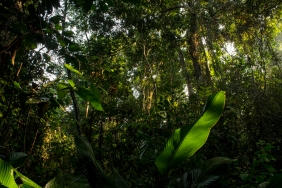NATURAL DISASTERS COULD WIPE OUT JAVAN RHINOS
Jakarta, Indonesia, May 12, 2017. Rhinoceros sondaicus) is currently in a critical condition, in addition to poaching, the shadow of extinction due to natural disasters is increasingly real, such as volcanic eruptions and tsunamis. This is evidenced by a recent study published in the prestigious global conservation journal, Conservation Letter. The study states that part of the Javan Rhino population in Ujung Kulon National Park (TNUK) is within the range of the Krakatau Volcano and close to the Sunda Basin, this location is a convergent area of tectonic plates that has the potential to cause earthquakes, and can trigger tsunamis. < br />
In this study, the researchers proved that the 2013 population of 62 individuals is a dense population in one habitat. The study also projected that a 10-meter tsunami, or about 33 feet in the next 100 years, could threaten 80 percent of the national park area, even though this area is the habitat with the highest population density of Javan Rhinos. Therefore, researchers urge the immediate development of new habitats for Javan Rhino populations that are safe from areas prone to natural disasters.
The establishment of a new habitat can be done by identifying the location and securing it, ensuring agreement with several stakeholders, including the government and local communities, and intensive monitoring in Ujung Kulon National Park to select the right Javan Rhino individuals for immediate relocation.
"This study makes a good momentum to save the Javan rhino immediately, we are racing against time," said Arnold Sitompul, Conservation Director of WWF-Indonesia.
Brian Gerber, Colorado State University and a member of the writing team, said that the results of the study show that a new population of rhinos is needed to protect this species.
"The Javan rhino is the most threatened land mammal in the world," he explained. "Right now, we need political and social willpower to move quickly and establish additional populations."
The study presents a detailed analysis of the Javan Rhino population, using camera trapping methods. In 2013, researchers obtained 1,660 photos of rhinos recorded from 178 camera trap locations to obtain an estimated population size of 62 individuals.
Researchers emphasized the importance of taking immediate action that can help increase the Javan rhino population in TNUK, increasing the survival rate for a portion of the population in the event of a natural disaster. This includes close guarding and protection of the remaining rhinos, monitoring, and improving habitat management including controlling the growth of Langkap (Arenga obsitulia), which is overrunning the area and inhibiting the growth of rhino food plants.
"We are proud of the success of managing the area to increase the Javan Rhino population, as shown in this study." said Ujang Mamat Rahmat, Head of Ujung Kulon National Park. "We have also conducted some research on prospective areas for a second habitat, and in the meantime, we will continue our work to improve security patrols and carrying capacity through invasive species control."
The IUCN Red List classifies the Javan Rhino as critical. The species has been depleted from most of its historical range beginning in the mid-nineteenth century, primarily as a result of excessive demand for rhino horn and other rhino products.
The researchers hope the study will inspire a revision of the Javan Rhino Strategy and Action Plan, which is due to expire in 2017.
The study, "Preventing Global Extinction of the Javan Rhino: Tsunami Risk and Future Conservation Direction," was launched on May 9 by Indonesian and global conservation experts from Ujung Kulon National Park, WWF-Indonesia, YABI - Indonesian Rhino Foundation, Global Wildlife Conservation and Colorado State University.
-FINISH-
For more information, please contact:
- Diah R. Sulistiowati
Campaign Coordinator for Terrestrial Species, WWF-Indonesia
Email: dsulistiowati@wwf.id, HP: +628111004397
- Lindsay Renick Mayer
Associate Director Communication, Global Wildlife Conservation lrenickmayer@globalwildlife.org - Mary Guiden Communications Coordinator, Colorado State University
Email: Mary.guiden@colostate.edu, Tel: (970) 491-6892
Editor's Note:
- The full issue of the journal's Conservation Letter "Preventing Global Extinction of the Javan Rhino: Tsunami Risk and Future Conservation Direction,"is available for download at http://bit.ly/2qnS94S
- The success of habitat management and protection shows a significant increase in the number of Javan rhinos, in 1937 the estimated number of Javan rhinos was only 20-25 individuals, in 2013 the population figure increased to 62 and 2015 to 63 individuals.
- Photos and Videos of Javan Rhinos can be downloaded at the following link http://bit.ly/2oo6oRY with copyright @WWF-Indonesia
.





